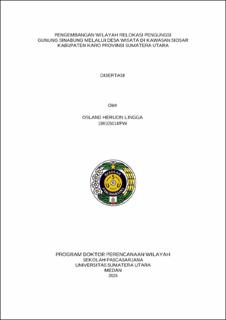| dc.contributor.advisor | Hasyim, Sirojuzilam | |
| dc.contributor.advisor | Purwoko, Agus | |
| dc.contributor.advisor | Thoha, Achmad Siddik | |
| dc.contributor.author | Lingga, Osland Herijon | |
| dc.date.accessioned | 2025-05-27T08:16:06Z | |
| dc.date.available | 2025-05-27T08:16:06Z | |
| dc.date.issued | 2024 | |
| dc.identifier.uri | https://repositori.usu.ac.id/handle/123456789/104151 | |
| dc.description.abstract | This study aims to see the effect of village development relocation of victims of the Mount Sinabung eruption into a tourist village on the Socio-Economy of the Siosar Area Community, to determine the influence of the Tourism Village on the development of the Siosar Village area of Karo Regency and to analyze the SocioEconomic Influence of the Community on Tourism Villages and to analyze Socioeconomic Influences the community towards the development of the Siosar Village area, Karo Regency with a tourism village as a moderating variable. The research approach that will be used in this study is a quantitative approach, namely to test the hypothesis of the influence of the development of the disaster relocation village of Mount Sinabung into a tourism village on the socio-economic community in Siosar Village, Tiga Panah District. Karo Regency. The sampling technique used is the probability sampling category with the Slovin method, where there are 232 samples taken using the Slovin method. The data collection technique in this study was a questionnaire. The calculated F value based on Table 6 is 232,427. The results obtained are Fcount (232.427) > Ftable (3.882) so it can be concluded that Ho is rejected, meaning that there is an influence between the development of the relocation village on the socio-economic community. The results of this study lie in the combination of the concept of developing refugee relocation areas and developing tourist villages as a solution to overcoming the impact of the eruption of Mount Sinabung on the community and supporting tourism in the Karo district. This research includes modeling and planning the development of the relocation area into a tourism village. This involves identifying potential areas, developing infrastructure, planning environmental management, and organizing local communities to manage tourism villages effectively. This can be an innovative approach and has not been widely implemented before in the context of developing natural disaster areas such as volcanic eruptions. | en_US |
| dc.language.iso | id | en_US |
| dc.publisher | Universitas Sumatera Utara | en_US |
| dc.subject | disaster relocation | en_US |
| dc.subject | Mount Sinabung eruption | en_US |
| dc.subject | tourist village | en_US |
| dc.subject | sustainable tourism | en_US |
| dc.title | Pengembangan Wilayah Relokasi Pengungsi Gunung Sinabung Melalui Desa Wisata di Kawasan Siosar Kabupaten Karo Provinsi Sumatera Utara | en_US |
| dc.title.alternative | Development of Relocation Areas for Mount Sinabung Evacuees Through Tourist Village in Siosar Area, Karo Subdistrict, North Sumatra Province | en_US |
| dc.type | Thesis | en_US |
| dc.identifier.nim | NIM198105014 | |
| dc.identifier.nidn | NIDN0018086303 | |
| dc.identifier.nidn | NIDN0001087402 | |
| dc.identifier.nidn | NIDN0003027502 | |
| dc.identifier.kodeprodi | KODEPRODI95003#Perencanaan Wilayah | |
| dc.description.pages | 130 Pages | en_US |
| dc.description.type | Disertasi Doktor | en_US |
| dc.subject.sdgs | SDGs 9. Industry Innovation And Infrastructure | en_US |


